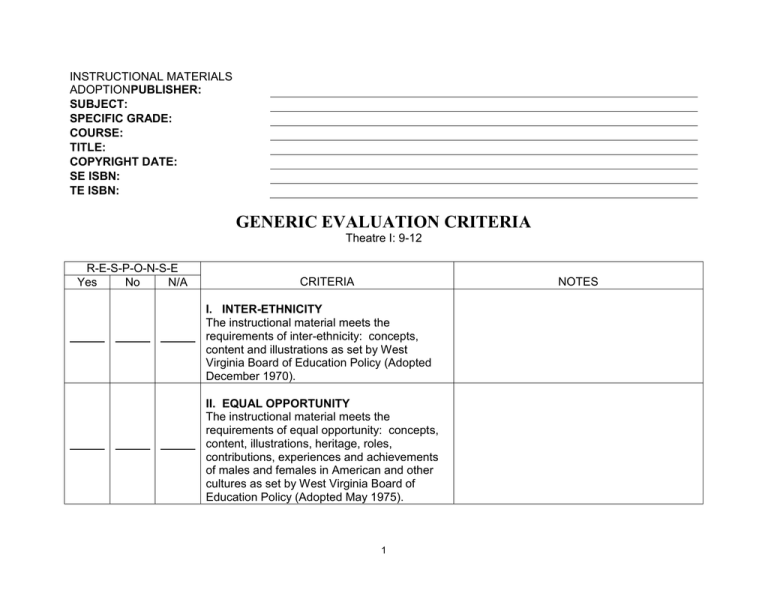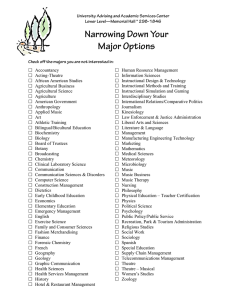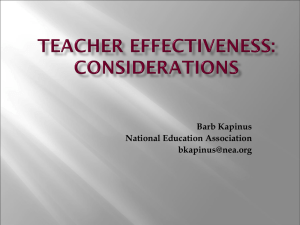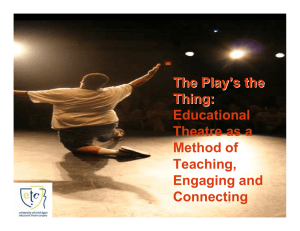GENERIC EVALUATION CRITERIA
advertisement

INSTRUCTIONAL MATERIALS ADOPTIONPUBLISHER: SUBJECT: SPECIFIC GRADE: COURSE: TITLE: COPYRIGHT DATE: SE ISBN: TE ISBN: GENERIC EVALUATION CRITERIA Theatre I: 9-12 R-E-S-P-O-N-S-E Yes No N/A CRITERIA NOTES I. INTER-ETHNICITY The instructional material meets the requirements of inter-ethnicity: concepts, content and illustrations as set by West Virginia Board of Education Policy (Adopted December 1970). II. EQUAL OPPORTUNITY The instructional material meets the requirements of equal opportunity: concepts, content, illustrations, heritage, roles, contributions, experiences and achievements of males and females in American and other cultures as set by West Virginia Board of Education Policy (Adopted May 1975). 1 GROUP II – 2009-2015 Theatre I: 9-12 (IMR Committee) Responses (Vendor/Publisher) SPECIFIC LOCATION OF CONTENT WITHIN PRODUCT I=In-depth A=Adequate M=Minimal N=Nonexistent I A In addition to alignment of Content Standards and Objectives (CSOs), materials must also clearly connect to Learning for the 21 st Century which includes opportunities for students to develop A. Learning Skills Thinking and Problem-Solving Skills. Information and Communication Skills. Interpersonal and Self-Direction Skills using the following 21 Century Tools B. 21st Century Tools Problem-solving tools (such as spreadsheets, decision support, design tools) Communication, information processing and research tools (such as word processing, e-mail, groupware, presentation, Web development, Internet search tools) Personal development and productivity tools (such as e-learning, time management/calendar, collaboration tools) C. Lexile Framework Lexile measures Resources for teachers, parents, and students to demonstrate how using Lexiles can improve student achievement. 2 M N INSTRUCTIONAL MATERIALS ADOPTION: GENERAL EVALUATION CRITERIA The general evaluation criteria apply to each grade level and are to be evaluated for each grade level unless otherwise specified. These criteria consist of information critical to the development of all grade levels. In reading the general evaluation criteria and subsequent specific grade level criteria, e.g. means “examples of” and i.e. means that “each of” those items must be addressed. Eighty percent of the combined general and specific criteria must be met with I (In-depth) or A (Adequate) in order to be recommended. 2009-2015 Theatre 1 (IMR Committee) Responses (Vendor/Publisher) SPECIFIC LOCATION OF CONTENT WITHIN PRODUCT I=In-depth A=Adequate M=Minimal N=Nonexistent I A For student mastery of content standards and objectives, the instructional materials will provide students with the opportunity to A. B. Multimedia 1. offer appropriate multimedia (e.g., software, audio, visual, internet access) materials. 2. provide a website which provides links to relevant sites as well as lesson plans, student activities and parent resources. 3. integrate technology into the curriculum. Scientifically-Based Research Strategies 1. provide explicit instructional strategies to present varied teaching models including but not limited to webbing, mapping, Venn diagrams and inverted pyramids. 2. promote writing skills and study techniques . 3. present varied teaching models with emphasis on differentiated instruction in content, process, and product. 3 M N (Vendor/Publisher) SPECIFIC LOCATION OF CONTENT WITHIN PRODUCT C. D. E. F. (IMR Committee) Responses I=In-depth A=Adequate M=Minimal N=Nonexistent Critical Thinking 1. emphasize questioning models to promote higher order thinking skills based on Bloom’s Taxonomy. 2. promote student-generated responses. Life Skills 1. address life skills (e.g., health related concepts, goal setting, application to career oriented goals, reference tools, and researching). 2. address habits of mind activities (e.g., literacy skills, interpersonal communications, problem solving, and self-directional skills). Classroom Management 1. include opportunities for large group, small group, and independent learning. 2. provide classroom management suggestions. 3. provide suggestions for differentiated instruction (e.g., practice activities, learning stations, assessment, lesson plans). Instructional Materials 1. address varied learning styles and multiple intelligences of students by including models. 2. provide extensive and varied opportunities to practice skills. 3. provide intervention, practice, and enrichment materials. 4 I A M N (IMR Committee) Responses (Vendor/Publisher) SPECIFIC LOCATION OF CONTENT WITHIN PRODUCT G. I=In-depth A=Adequate M=Minimal N=Nonexistent 4. provide exemplars of critique and research-based writing. 5. continue skill or strategy instruction across several instructional sessions to expand the applicability and utility of the skill or strategy. 6. connect previously taught skills and strategies with new content and text. 7. cumulatively build a repertoire of multiple strategies that are introduced, applied, and integrated throughout the course of study. Assessment 1. provide opportunities for assessment based on performance-based measures, open-ended questioning, portfolio evaluation, rubrics, and multimedia simulations. 2. provide on-going progress monitoring. 3. provide rubric-based differentiated assessment. 5 I A M N INSTRUCTIONAL MATERIALS ADOPTION: GENERAL EVALUATION CRITERIA The general evaluation criteria apply to each grade level and are to be evaluated for each grade level unless otherwise specified. These criteria consist of information critical to the development of all grade levels. In reading the general evaluation criteria and subsequent specific grade level criteria, e.g. means “examples of” and i.e. means that “each of” those items must be addressed. Eighty percent of the combined general and specific criteria must be met with I (In-depth) or A (Adequate) in order to be recommended. GROUP II – 2008-2014 Theatre I: 9-12 (IMR Committee) Responses (Vendor/Publisher) SPECIFIC LOCATION OF CONTENT WITHIN PRODUCT I=In-depth A=Adequate M=Minimal N=Nonexistent I A For student mastery of content standards and objectives, the instructional materials will A Scriptwriting 1 Provide opportunities to adapt a variety of written materials for classroom performance (e.g. stories, children’s books, myths, folktales, fables, personal experiences, songs). 2 Provide opportunities to analyze the content of the material (e.g. stories, children’s books, myths, folktales, fables, personal experiences, songs) for dramatic elements including exposition, conflict, climax, resolution, character relationships, actions and obstacles. 3 Provide opportunities to experiment with stories to create a variety of theatrical forms (reader’s theatre, improvisation, tableau, pantomime). 4. Provide opportunities to rewrite stories to contain a simple plot structure and dialogue which demonstrate understanding of basic dramatic elements. 6 M N Acting B C 1 Provide a variety of examples and exercises to demonstrate the focus, concentration, observation and believable action necessary to sustain a character, improvisation or scene. 2 Provide a variety of examples and exercises to experiment with a variety of ways to use the body and voice to react to actions and given situations (i.e. a child who has lost a favorite toy; an old man who is hungry but has no money) in a. solo, b. partner, c. group improvisations and performances. 3 . Provide a variety of examples and exercises to create and sustain believable characters who have internal and external qualities with wants, needs, objectives, and relationships in a. solo, b. partner, c. group improvisations and performances. 4. Provide opportunities to discuss how style influences the creation of character. 5. Provide opportunities to discuss how genre influences the creation of character. 6 Provide opportunities to communicate responsibly and respectfully in ensemble efforts and during critique. Designing and Producing 1 Provide opportunities to recognize the ways in which technical elements contribute to the audiences’ understanding and appreciation of a performance. 2 Provide opportunities to identify the basic technical elements of theatre. 7 3. Provide opportunities to explain how the constraints of physical space affect the use of the basic technical elements of theatre. 4. Provide opportunities to examine a variety of dramatic texts for cultural clues and generate a list of production requirements. 5. Provide opportunities to examine a variety of dramatic texts for historical clues and generate a list of production requirements. 6. Provide opportunities to experiment with visual elements that convey environments (time, place) which support the text/story. (e.g. How can we use minimal scenery to convey a location? What costume pieces might help the audience understand the status of a character? What kind of lighting will suggest dawn?) 7. Provide opportunities to experiment with aural elements that convey environments (time, place) which support the text/story. (e.g. What sounds might help the audience imagine the location in a scene?) 8. Provide opportunities to demonstrate technical vocabulary to collaboratively and safely solve the problems of a. creating functional scenery, b. properties, c. lighting, d. sound, e. costumes, f. makeup. 9. Provide opportunities to demonstrate technical knowledge to collaboratively and safely solve the problems of a. creating functional scenery, b. properties, c. lighting, d. sound, e. costumes, f. makeup. 8 D 10. Provide opportunities to demonstrate technical skills to collaboratively and safely solve the problems of a. creating functional scenery, b. properties, c. lighting, d. sound, e. costumes, f. makeup. 11. Provide examples of a. coherent stage management plans b. promotional plans c. business plans 12. Provide opportunities to articulate how each position in the production team hierarchy contributes to the production process. Directing 1 Provide opportunities to identify the role of the director. 2 Provide opportunities to identify the responsibilities of the director. 3. Provide opportunities to analyze texts for possible meanings. 4. Provide opportunities to research selections related to a. historical, b. cultural, c. social context of a play. 5. Provide opportunities to articulate how the director’s concept affects the approach to and outcome of a scene or play. 6. Provide opportunities to articulate how the director’s artistic choices affect the approach to and outcome of a scene or play. 7. Provide opportunities to demonstrate possible interpretations for text (improvisations, scenes, plays) using a variety of techniques such as discussion, stage pictures, tableaux, and pantomime. 9 E 8. Provide opportunities to apply the vocabulary of directing while discussing directorial choices with a small ensemble for improvised or scripted scenes. 9. Provide opportunities to apply the vocabulary of staging while discussing directorial choices with a small ensemble for improvised or scripted scenes. 10. Provide opportunities to apply the vocabulary of acting while discussing directorial choices with a small ensemble for improvised or scripted scenes. 11. Provide opportunities to practice respect, sensitivity and leadership in ensemble activities. Making Meaning through Connections 1 Provide opportunities to research how the other art forms are used to enhance the expression of ideas in a theatre production. 2. Provide opportunities to research how the other art forms are used to enhance the expression of emotions in a theatre production. 3. Provide opportunities to identify the origins and historical uses of theatre as popular entertainment within Western and nonWestern cultures. 4. Provide opportunities to identify the origins and historical uses of theatre as ritual within Western and non-Western cultures. 5. Provide opportunities to research the development of dramatic forms, production practices and theatrical traditions across a. cultures b. historical periods. 6. Provide opportunities to research and discuss the lives, works, and influence of representative theatre artists in various a. cultures b. historical periods. 10 7. Provide opportunities to explore cultural clues in dramatic texts and determine the practicality of the information to assist in making artistic choices for use in a. informal b. formal productions. 8. Provide opportunities to explore historical clues in dramatic texts and determine the practicality of the information to assist in making artistic choices for use in a. informal b. formal productions. 9. Provide opportunities to explore symbolic clues in dramatic texts and determine the practicality of the information to assist in making artistic choices for use in a. informal b. formal productions. 10. Provide opportunities to explore the range of theatre careers including performance, production, technical theatre, teaching and supporting occupations. 11. Provide opportunities to develop personal aesthetic criteria for critiquing dramatic texts and performances. F. c.Assessment F 1 Provide a variety of formative and summative assessment tools (examples: performance rubrics check lists, objective tests, writing prompts, constructive response, etc.). 11





